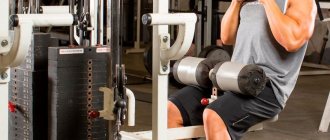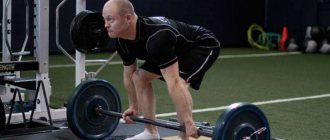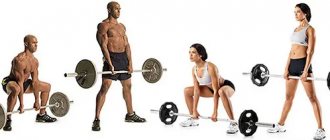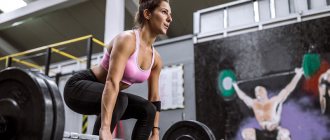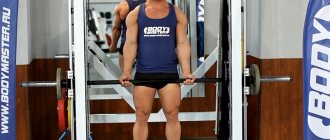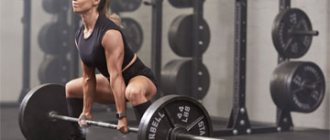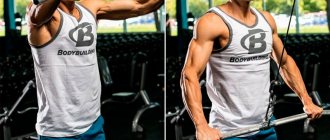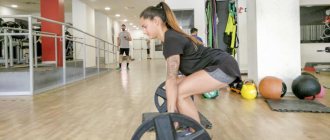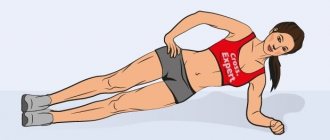- October 21, 2018
- Workouts in the gym
- Nikita Novikov
The T-bar row is one of the most popular and effective exercises for working the back muscles in the gym. It is not as simple to perform as it might seem at first glance, and before adding it to your training system, you need to thoroughly study the technique of its implementation, features and nuances. It is this topic that we devoted our article today. We wish you pleasant reading!
Advantages
The main advantages of the T-bar row in the simulator include:
- The ability to use a neutral grip (when the palms “look” at each other). “What’s wrong with that?” - you ask. It's simple. The fact is that from a biomechanical point of view, this position is the most optimal for performing traction movements, which better loads the back muscles.
- By performing a bent-over T-bar row, you'll achieve a more aesthetically pleasing contour to your mid-trapezius muscles, as well as highlighting a lot of the smaller muscles.
- Work of a large number of muscles. Despite the fact that this exercise is considered isolated, during its execution the lower and middle part of the back is worked, and the abdominal press also receives an indirect load.
- The ability to take more weight than with a classic bent-over barbell row. A smaller volume of work by the stabilizer muscles allows you to specifically load the back muscles, and even with more weight. Thus, the load that the involved muscles receive increases.
What muscles work?
The dynamic load falls on the latissimus, minor and teres and rhomboid muscles of the back.
The trapezius muscles, rear deltoids and triceps work a little less. The stabilizers are the spinal extensors, gluteal muscles, hamstrings and quadriceps.
Execution technique
Now we come to the main topic of the article, namely how to perform T-bar rows.
- Prepare the machine for use and select the weight you need.
- Take the starting position: position yourself near the machine so that it is between your legs. Your feet should be firmly planted on the stands, and your grip on the handles should be slightly wider than shoulder-width apart. The knees are slightly bent, the back is straight, the gaze is directed forward.
- As you exhale, pull the barbell with the weight towards you. At the top, squeeze your shoulder blades together to squeeze your back muscles as tightly as possible.
- While inhaling, lower the apparatus to its original position, but so that the bar does not touch the floor.
- Repeat the movement as many times as you planned.
The Importance of Stretching
The exercise places specific demands on form. Do you know why most men cannot bend forward normally? The reason here is not pain in the lower back, or even stiff hamstrings. The body position is usually stabilized by inflexible ankles. You will have to start the workout by stretching in a split squat with the heel of the back leg lowered to the floor. It is enough to stretch for 30-40 seconds on each side to make the bend more free.
Before training, it is also recommended to warm up the hip joints and shoulders with rotations. Otherwise, the tilt won't be deep enough to engage your back, and you won't be able to perform the movement correctly.
Execution Features
As we said earlier, the T-bar row has its own characteristics and nuances. We'll talk about them now:
- the body should be at an angle of 45 degrees relative to the bar;
- before you start performing the exercise, you need to balance your stance so that the weight does not pull you forward;
- at the top point the projectile should almost touch your pectoral muscles;
- during execution, keep your hands as close to your body as possible;
- weight must be controlled along the entire trajectory of movement. The bar should move smoothly;
- movements should be uniform, and pauses and stops should be kept to a minimum.
Tips for implementation
To make the exercise we are discussing not only effective, but also safe, we recommend that you familiarize yourself with the recommendations below.
- Do not start the exercise with your working weight, as this may lead to injury. Before the first working approach, it is better to do a couple of warm-up sets with lighter weight.
- You should pay attention to the time and speed of the exercise. You don’t need to do it very quickly, try to control your every movement.
- Keep your back straight at all times. If your back is crooked during the exercise, then a very large load will be placed on your spine. This, as you can already understand, can lead to injury.
- When lowering the barbell, do not fully extend your elbows. This can also cause serious injury.
- Avoid jerking movements and “cheating”. In order to get the desired result from the exercise, it must be performed correctly and technically. If you “cheat”, most of the load will be “eaten” not by the broadest, but by third-party muscle groups. In addition, such a technique can be extremely dangerous.
- If possible, perform the movement near a mirror to control your technique.
- Don't forget that the T-row is primarily an exercise for the latissimus dorsi muscles. While performing it, try to exclude biceps and other auxiliary muscle groups from the work as much as possible.
- This exercise can be done with less effort if you use one small “life hack”. What do I need to do? Just take small-diameter pancakes. The fact is that when using plates with a large diameter, the amplitude of movement is greatly shortened, which is why the effectiveness of the exercise suffers. In addition, for many athletes this position can be simply uncomfortable. If possible, take small but heavy pancakes. It will be much more convenient if you install several small plates on the bar rather than one very large one.
Execution options
Typically, athletes use three variations of the T-bar row:
- Deadlift with a neutral grip. We have previously mentioned this grip and also talked about its advantages. To perform this version of the exercise, you need to use narrow handles of the simulator, which are located in parallel. Unfortunately, not all exercise machines have such handles.
- Reclining row with emphasis on the chest. This variation of the exercise is good because when it is performed, a significant part of the load is removed from the lumbar region. This makes the exercise several times safer. Make sure that the chest is pressed against the support with the working weight.
- Pull of one barbell ring. It just so happens that not all gyms and fitness centers have a machine with a T-bar. What to do in such a situation? In this case, we offer you another “life hack” using a regular barbell. One end of this projectile must be fixed so that it is in the same position throughout the entire movement, and the weight you need must be set on the other. Place your hands as close to the plates as possible, and then begin to perform the exercise according to the same principle as the classic T-row. To increase the range of movement, you can use a special step platform.
General recommendations
We have already told you about how to do the T-bar row and what nuances should be taken into account during execution. Now we would like to give some tips that will help you in your training.
- Warm up well. This applies not only to back training and not only to performing bent-over T-bar rows, but to all workouts in general. During the warm-up, the athlete warms up his joints and tendons, thus preparing them for working with heavy weights. Failure to warm up, as you might have guessed, can lead to serious injuries.
- Let your muscles rest. The back is a large muscle group and, like all large muscle groups, it requires time to recover. Many beginning athletes naively believe that if they exercise certain muscles very often, they will grow faster. In fact, such a strategy will not lead to good results, but to a state of overtraining. This is why fitness and bodybuilding experts recommend training your back no more than once or twice a week.
- Do everything technically. The T-bar row is a fairly traumatic exercise, so you should approach it very carefully. Before adding it to your training program, make sure that you have mastered the technique of performing this movement. It is best to ask a coach or more experienced athlete to watch you do this exercise. If something happens, he will be able to point out your shortcomings and give practical advice.
We can finish here. We hope that this article was interesting to you and you received a lot of interesting information!
Number of repetitions and sets of back exercises
The number of repetitions and approaches depends on your goals:
12-15 reps in 3 sets for each exercise
Beginners in the gym need to do at least 12 repetitions with a small weight in order to learn the correct technique, the body remembers the mechanics of the movements. Then gradually increase. For the first time, train without any weights at all or with the lightest dumbbells/empty bar, or at home. At each workout, try to do more repetitions than the last. When you do all 15 reps easily, increase the working weights.
Such caution is necessary so as not to knock off the little toe on your left foot or other vital parts of the body with a heavy dumbbell.
High-intensity workout for fat burning and muscle cutting
: Lots of reps and little rest to keep your workout intensity high.
6 to 8 reps in 3-5 sets
Mass training. Do more basic back exercises with free weights and low reps.
